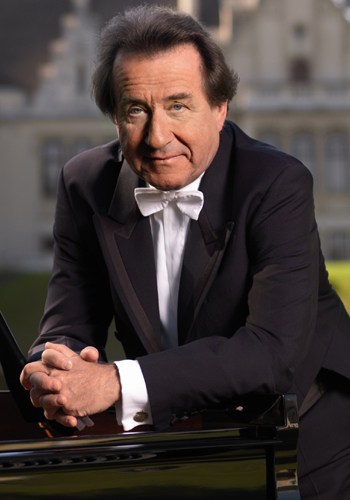
Many of us might not have known about pianist Rudolf Buchbinder earlier. However, we all learned his name well last month: He was the hero of the complete Beethoven sonata saga at the Sureyya Opera House.
He took the stage once again last week, this time at the Zorlu Center PSM, again under the organization of Borusan Sanat (Borusan Arts). This time, however, Buchbinder was on the stage not by himself, but as the piano soloist of the Borusan Istanbul Philharmonic Orchestra. And, he performed not sonatas of Beethoven, but one of his majestic concertos: Piano Concerto #3 in C minor (Opus 37).
As we sat waiting for the program to start, I overheard conversations related to the sonata performances of the past month. One woman mentioned “having attended only one.” Another woman had attended two. I gave myself a badge of honor for having witnessed four, and considered myself very fortunate to have heard all of my favorite sonatas performed in series. The lights dimmed and the spotlight turned on stage as Buchbinder entered and made his way to the Steinway grand piano. Enthusiastic, eager applause came from our side.
Beethoven’s Piano Concerto #3 started in an allegro con brio (fast with vigor) movement. The starting notes of the orchestra were majestic, but delicate and beautiful. Just like in the sonatas, the meter, volume, and rhythm of the music did not matter. The most fiery, rhythmic, “loudest” of notes were also, at the same time, intricately gentle, deep with emotion. The notes were fast and vigorous, but this implied rejuvenating energy rather than force. The music, the sounds coming from the piano mimicked water droplets from a refreshing spring. The violins, cellos, double bass, and the piano all took part in this composition, playing in unison, in crescendos, diminuendos, pianos and fortes, and in myriad instrumental dialogue, ensemble, and harmony.
The largo (slower and “large”) and rondo, allegro movements took us deeper into compositional bliss, as the orchestra and the piano engaged in heavenly dialogue. The cello and subtle bass provided the backbone of the violins’ notes, while the piano came in with the gentlest of notes. It was a mystical paradise, with the winds adding aura, and refreshing, misty notes of crystal springing to life on the ebony and ivory keys of the grand piano. There were violin pizzicatos (“plucking of the string”), joyful horns, and gentle, subtle winds. An instrument would whisper the main theme, and the rest would pick it up in turn or unison, build up on it, play around it, engage in an interchange of musical dialogue, or take it on and venture into new lands. Buchbinder and Beethoven had teamed up again for an unforgettable evening of musical paradise.
Applause then brought Buchbinder back for an encore in which he surprised us by playing a Strauss of his native Austria. We then had a fifteen minute break to soak in the aura and energy of the perfomance past, and the curtain called again.
In the second half, we were in for a total change of mood and style. The selection was Mozart’s Requiem. On the stage was the State Polyphonic Chorus, with soprano Chara Skerath, mezzo-soprano Rachel Frenkle, tenor Frederic Antoun, and bass Markus Marquardt on the solo parts, and Cemi’i Can Deliorman as chorus master.
Requiem is a word derived from the Latin terms requis, meaning “quiet” and “rest.” It’s a composition of Roman Catholic tradition that refers to “Mass celebrated for the repose of the dead” or “any musical service, hymn, or dirge” of similar intent. Many composers, including Verdi, Dvorak, and Faure, have also tackled it. Even if you are not into classical composition or sacred music, you may remember it as the moving, beautiful composition bidding Princess Diana farewell in 1997, at her funeral broadcast live the world over. Or, if you have ever watched the classic movie Amadeus, on the life of Mozart, you will remember the manipulative, antagonist Salieri extracting notes for the piece out of Mozart as the musical hero draws his last breath. A composition for the dead soul, and by tragic coincidence the final piece of the immortal Mozart, was composed as the composer felt his own end treading closer and closer.
Generally, when one says Requiem, it is understood to be Mozart’s. An uncheerful theme, but nevertheless a beautiful piece. In the movie Amadeus, there is a scene in which the King finds the opera Don Giovanni “too long” and asks Mozart to truncate it by a few measures. Mozart stands up to the King and says, “If a note had not been put there deliberately, it would not have been there. Every note in there has its individual role and place, there is no truffle.” And so, absolute perfection is the trademark of Mozart’s work, and Requiem too is as beautiful, as immaculate, as magical as music can get. And, even though the short-lived life of Mozart meant that he was unable to finish the piece, his pupil Franz Xaver Süssmayer was left with enough of a foundation in the unfinished sections to complete the work and have it placed among the pillars of classical music.
Aware of the actual raison d’etre of Requiem, and further knowing the story behind that of Mozart’s, the second interval of the evening weighed down the spirit. Yet, the music was breathtakingly beautiful; tranquil at times, and at others reminiscing the majestic moments of life. There were moments that were sad and eerie, foreshadowing the final departure of life. But, it was also glorious and uplifting, celebrating the splendor and magnificence of life and all conquests vanquished.
Naturally, there were no encores of Requiem. But it was nonetheless an evening of the greatest works of the greatest masters, and Beethoven’s Piano Concerto #3 and Mozart’s Requiem were more than fulfilling. We left the auditorium with the celestial grandness and beauty of the latter lingering in our spirit, and the legacies of both artists further attesting to the immortality of music.










